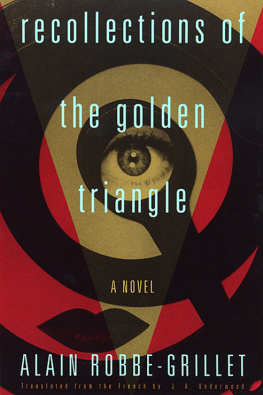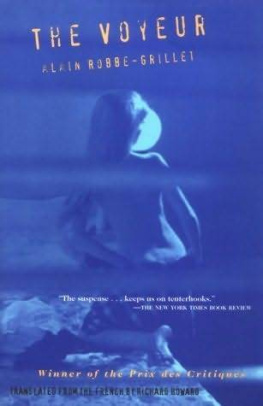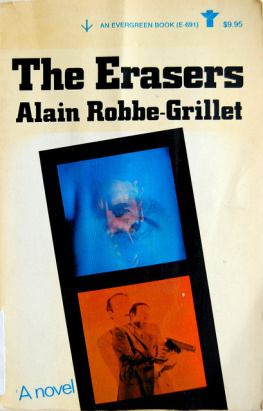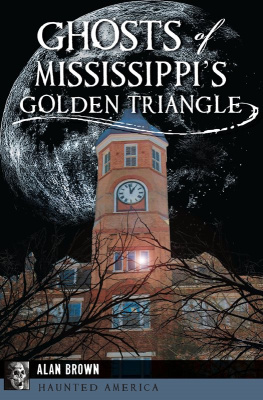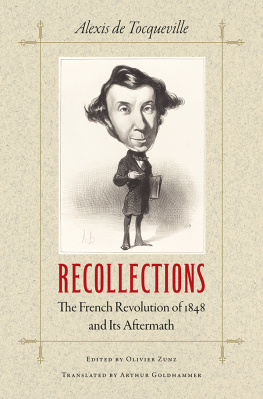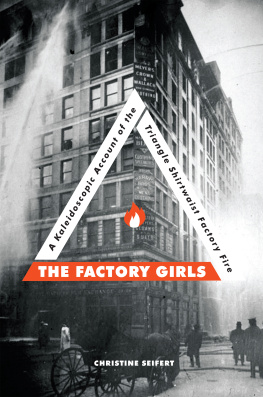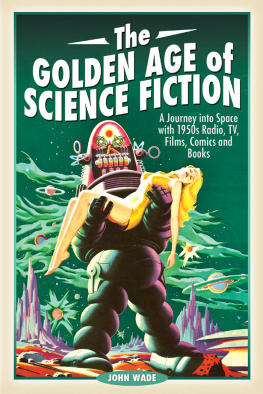
Recollections
of the
Golden Triangle
OTHER WORKS BY ALAIN ROBBE-GRILLET
Published by Grove Press
Djinn
Topology of a Phantom City
Project for a Revolution in New York
La Maison de Rendez-vous
For a New Novel: Essays on Fiction
Last Year at Marienbad
In the Labyrinth
Jealousy
The Voyeur
The Erasers
Recollections
of the
Golden Triangle
ALAIN ROBBE-GRILLET
TRANSLATED FROM THE FRENCH BY
J.A. UNDERWOOD

Grove Press
New York
Copyright English translation J. A. Underwood 1984
First published in Great Britain 1984 by John Calder (Publishers) Ltd, London
Copyright Les Editions de Minuit 1978
Originally published in French, 1978, under the title Souvenirs du triangle d'or by Les Editions de Minuit, Paris
All rights reserved.
No part of this book may be reproduced, stored in a retrieval system, or transmitted in any form, by any means, including mechanical, electronic, photocopying, recording or otherwise, without prior written permission of the publisher.
First Grove Press Edition 1986
ISBN 0-8021-5200-7
eISBN 978-0-8021-9054-3
Library of Congress Catalog Card Number: 86-45233
Cover design by John Gall
Cover illustration by Alfred Gescheidt/Image Bank
Printed in the United States of America
Grove Press
154 West 14th Street
New York, NY 10011
Recollections
of the
Golden Triangle
An impression, already, that things are getting narrower. Don't puzzle too much. Don't turn round. Don't stop. Don't force the pace. For no visible reason, no reason. Speed has become necessary. The imminent discovery of the temple by the security forces means that the overall plan has to be modified and above all hurried into execution. But without changing anythingit's too lateof the elements that make it up, and that are now inevitable.
There is nothing exceptional about the entrance to the building from the street: a black-painted door of medium size, in other words neither smaller nor larger than its neighbours, with restrained mouldings in Directoire style. It appears to be made of wood, like the others. Its only distinguishing detail, though one doesn't notice this at first, is the complete absence of any handle, keyhole, latch, knocker, bell, etc. There is no guessing whether it opens to the right or to the left. Come to that, it might not even be a door. Avoid this course; it leads nowhere.
The stone surroundpilasters with vertical flutingis topped by a triangular pediment in the classical style enclosing a second, equilateral triangle standing point downwards and touching the sides of the first with all three vertices. An eye, carved in bas-relief, occupies the centre; but instead of lying horizontally, as in nature and in the manner normally adopted for this type of symbol, the gap between the eyelids here forms a vertical spindle marking the axis of symmetry of the overall design. The hole representing the pupil is pierced so deeply that there is no telling how far in it goes, possibly because of the height at which it is situated in relation to normal eye level.
People will doubtless have realized already, alas, that the door is operated by means of an electronic signal emitted by a small portable device that must be applied to a specific point on the lower panel, etc. (No ratiocinations, no regrets, no going back.) The stone eye serves no purpose, at least not as things stand.
This is where the story starts, after an interruption, probably, a fairly major one giving the impression that things are getting even narrower: just the opposite of an opening. The system as a whole remains, for the moment, strictly motionless.
Motionless again, yes, probably, but with something temporary, brittle, an element of tension, as if over all this calm there reigned, invisible as yet, a threat, a fear, a death sentence already pronounced, still silent, yes, no doubt, but with an almost indiscernible breathing, or whistling as of a wind that, without appearing to be of any force, nevertheless shifts the grains of sand on the beach one by one, carrying them imperceptibly towards the abandoned terrace where, bit by bit, they build up in sinuous little parallel ridges on the gappy grey planks that here blend without a break into the very slight slope of powdery, uneven ground moulded by the treading of innumerable feet the day before, or over the past few days, down to the water, now slack once more, yes, probably, but still breaking at high tide in a tiny wave endlessly repeating itself with a gentle, periodic hiss of such regularity that one might not hear this either, so integral a part is it of this scene caught by the dawn, as one might also fail to be aware of the laboured, soundless flight of a large, pale-coloured pelican moving away to the left, skimming the water about ten metres out, roughly parallel to where the water's edge is marked by a festoon of foam that no sooner vanishes than it is brought back by the inexhaustible and, in any case, from where I am, invisible wavelet, it being too far off, too low down, too much in the background.
Facing me, which is to say coming towards me in the opposite direction to that in which the big bird disappeared, the noticeably livelier silhouette now tracing its arabesques soon turns out to be that of a naked girl mounted bareback on a colt with a flowing mane in the manner currently in vogue among kids on the west coast; advancing erratically, following a capricious course that means they can be admired from every angle in turn and at closer and closer quarters, her long, blue-black hair and the horse's streaming mane and tail like licks of golden flame whirl and gambol in the warm morning breeze as the girl tries without stirrups or spurs to make her pale-brown mount venture farther into the sea, which is splashed up on all sides by its restive hoofs, falling back amid the tinkling laughter of the amazon whose slender, spume-flecked body gleams with a metallic lustre, suddenly, lit by the rising sun.
Having almost reached the foreground, the young rider smelling of iodine and salt in turn disappears to the right behind me, my little bride of the moment; and I do not look round to follow her with my gaze. I even fade further into the indistinct background of scattered tables and stacked chairs in the corner of the terrace when I spot, coming in the same direction as if pursuing a fugitive, three hunters armed with rifles, booted and clad in the traditional leather garb with the long, curved feather in the hat. They are walking fast, in line abreast, along the water's edge, the blued-steel guns held in their left hands pointing downwards at an angle, ready to be raised, their right index fingers on the triggers. Having crossed the picture from left to right, but moving much more quickly, they too, with one stride, pass behind me.
Almost immediately a shot rings out in the silence, apparently very close, followed without any interval by a sharp cry like the rending call of a gull, though none is present; then there is a long-drawn-out whinny and a second, identical detonation, clear and violent, in which I recognize the combat Mauser used by the auxiliary militia, putting a brutal end to the plaintive wail that had been going on and on, a sound almost human, calling to mind that made in the forest by the fine animal with the flesh-coloured plumage known here as the bird-woman. There is nothing after that but jumbled sounds of water that has been set swirling by some falling body, or heavy footsteps, or by the sea beating furiously against an unexpected rock, mingling its eddies and the slaps of abruptly converging waves with the galloping of the crazed horse whose whinnies, briefer now, are already less distinct.
Next page
